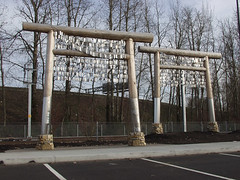And are our cities amusement parks or places to live and work (and spend money)
(I am part of the problem on this myself, believing in harvesting cultural heritage and cultural assets for economic development purposes.) See "Turning cities into art galleries" from the Christian Science Monitor.
From the article:
Acknowledging the complexities a public artist must navigate, more art schools, such as USC's Roski School of Fine Arts in Los Angeles, are offering programs in public-art studies and practice. "They recognize it is a discipline that requires special training," says Janney.
Public art is markedly different from a private gallery show, admits Steiner, since it can "make ripples in the life of a city and impact people who see it."
Just last night I was talking with my girlfriend (repeating myself really), about what I think of as the most powerful public art installation I have ever seen, about the internment of Japanese-Americans during World War II, at the Expo Center yellow line Tri-Met light rail stop in Portland, Oregon.

Valerie Otani addresses the theme of Japanese relocation during World War II at the site of the 1942 Portland Assembly Center. Traditional Japanese timber gates strung with metal "internee ID tags" mark station entrances. Vintage news articles are etched in steel and wrapped around the gate legs. (The artist spoke to us on our tour. And the headlines of the newspapers included in the work were vicious and racist. )
What blows me away about this installation is that the Tri-Met authority isn't gutless, that they spent public money on challenging public art. I just don't see that kind of willingness to challenge being present on the part of typical government agencies or elected officials in the DC region.
Labels: cultural heritage/tourism, destination management, public art, tourism



0 Comments:
Post a Comment
<< Home